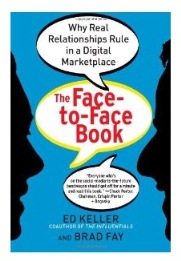Social Marketing: Past is Prologue - Ed Keller

On May 22, my new book, The Face-to-Face Book: Why Real Relationships Rule in a Digital Marketplace will be published. Coauthored by Brad Fay, it is a book about the hugely important social wave that is rolling across the world of business today. But unlike many books and articles argue that online social networks are creating this social wave, we argue that the largest and most important part of social influence is that which happens when conversations happen in the real world, face to face. There is a vast array of tools and approaches that can be tapped by marketers to drive these real world conversations. You can download a free excerpt from the bookhere.
argue that online social networks are creating this social wave, we argue that the largest and most important part of social influence is that which happens when conversations happen in the real world, face to face. There is a vast array of tools and approaches that can be tapped by marketers to drive these real world conversations. You can download a free excerpt from the bookhere.
While researching the book, I reviewed the history of word of mouth and social influence. It was a clear reminder that past is prologue. From a marketing perspective, focus on the role of word of mouth was quite robust in the 1940s, '50s and into the '60s, before marketing was overtaken by the era of the Mad Men and "the Golden Age of Advertising" and long before the Internet or online social networking.
The '40s and '50s, we were the dawn of the mass media era, and many people ascribed vast power of the radio and the emerging medium of television. A prevailing theory of the time, known as the "hypodermic needle model" or "magic bullet theory," held that powerful mass media could "inject" ideas into people who would directly (and passively) accept and act on those messages. One incident often cited in support of this theory was the 1938 radio broadcast of the War of the Worlds, and the subsequent nationwide panic that ensued.
To those who advocated the hypodermic needle model, this "cause/effect" was proof that people would hear what the media reported, and take immediate action. But soon thereafter, this theory about how mass communications works was discredited by the eminent Columbia University researchers Paul Lazarsfeld and Elihu Katz.
Their argument was based on research – known as "the Decatur study" -- the purpose of which was to ascertain how average women in a typical American town (Decatur, Illinois) made decisions about everyday products and services. The results of the Decatur study were published in 1955 in a seminal book called Personal Influence by Katz and Lazarsfeld. Among the many findings from Personal Influence were two that are particularly relevant to today's social era.
People Persuade, not Advertising
The first was that the mass media do not "cause" people to do things or make purchase decisions in isolation, as the "hyperdermic theory" held. Rather, it identified an important relationship between advertising and word of mouth. The study noted, "The traditional image of mass media must make room for 'people' as intervening factors between the stimuli of the media and resultant opinions, decisions, and actions." Katz and Lazarsfeld went so far as to say that mass media, generally, don't do a very good job at persuasion, but rather tend to reinforce pre-existing views. Persuasion, they said, happens best when mass media connect with everyday consumer influencers who pass along the message to others, and in so doing are better able to generate new customers. They called this the two step-flow of the mass media.
Which brings us to a second important and lasting finding. In their discussion of these "everyday consumer influencers," Katz and Lazarsfeld were the first to document the impact of influencers – not people in official positions of power but a group of everyday people, be they family, friends, or neighbors, to whom people look for advice and recommendations because they find them to be trustworthy and knowledgeable. They observed that influencers are heavy users of media, who tend to learn about and share with others things that are new, interesting, and important. "Leadership at its simplest," they called it: "It is casually exercised, sometimes unwitting and unbeknown, within the smallest grouping of friends, family members and neighbors. . . it is the almost invisible, certainly inconspicuous, form of leadership at the person-to-person level of ordinary, intimate, informal, everyday contact. . ."
Remarkably, many of the fundamental truths noted by Katz and Lazarsfeld still pertain today, despite massive changes in the media and marketing landscape. Their findings are an important reminder that people are the force that drives social influence; and that media and technology are enablers of rather than cause people's desire to share and learn from each other.
In my next post I'll continue this historical review, focusing on the first advice to advertisers to embrace word of mouth advertising from a 1966 Harvard Business Review article – it is also quite fresh and relevant to today's times.
Ed Keller, CEO of theKeller Fay Group, has been called "one of the most recognized names in word of mouth." The publication of Keller's book,The Influentials, has been called the "seminal moment in the development of word of mouth." His new book,The Face-to-Face Book, is coming out in May 2012. You can follow Ed Keller onTwitter,FacebookandGoogle+, or contact him directly at ekeller@kellerfay.com.
Read all Ed’s MediaBizBloggers commentaries at WOM Matters.
Check us out on Facebook at MediaBizBloggers.com
Follow our Twitter updates @MediaBizBlogger
The opinions and points of view expressed in this commentary are exclusively the views of the author and do not necessarily represent the views of MediaBizBloggers.com management or associated bloggers. MediaBizBloggers is an open thought leadership platform and readers may share their comments and opinions in response to all commentaries.


